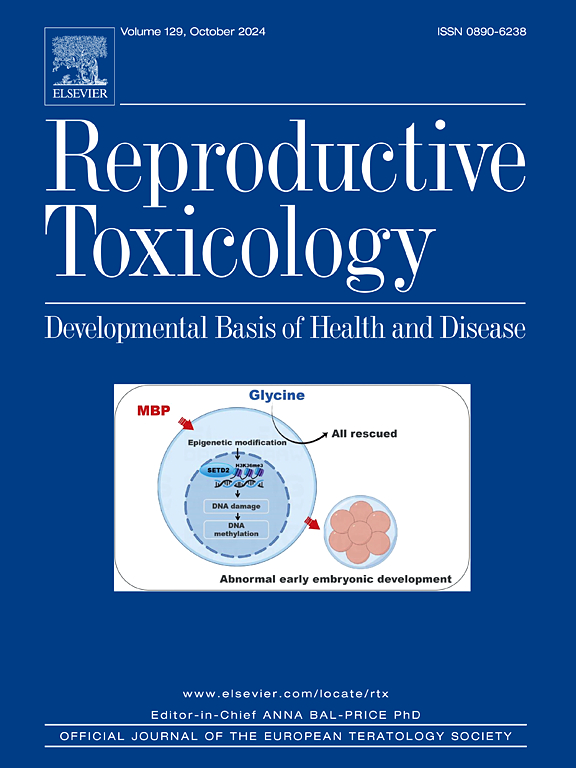妊娠期三氯生暴露及其对儿童神经发育的影响——一项系统综述。
IF 3.3
4区 医学
Q2 REPRODUCTIVE BIOLOGY
引用次数: 0
摘要
三氯生(TCS)是一种亲脂抗菌剂存在于商业和保健产品。尽管TCS具有有益的特性,但它会破坏甲状腺激素的稳态,可能与代谢紊乱、心脏毒性和癌症风险增加有关。产前TCS暴露和不良神经行为结果的证据有限。本系统综述旨在验证产前暴露于TCS是否与神经行为障碍有关。对怀孕期间暴露于TCS的孕妇进行观察性研究。检索截止到2024年2月27日的MEDLINE、EMBASE、Scopus、Web of Science和LILACS数据库。首先筛选题目和摘要,然后由两名独立审稿人阅读全文。数据提取独立进行,冲突通过与第三方审稿人达成共识来解决。纳入的研究使用适应性的Downs和Black工具进行评估,并进行定性综合。证据的确定性采用GRADE评价。研究方案已在PROSPERO注册(CRD42024526426)。在17项研究中,14项队列研究符合纳入标准。样本量从193对到794对孕妇和儿童不等。妊娠期间暴露于TCS导致中位浓度从0.40ng/mL到28.2ng/mL。四项研究表明,产前TCS暴露与神经发育缺陷(如外化问题、注意力问题、多动、躯体化、情绪症状、社会意识和沟通)之间存在潜在关联;相比之下,8项研究没有发现明显的影响。这些研究证据的确定性较低。考虑到异质性和混杂因素,需要进一步的研究来证实产前TCS暴露导致神经行为障碍。本文章由计算机程序翻译,如有差异,请以英文原文为准。
Gestational triclosan exposure and its effects on childneurodevelopment – A systematic review
Triclosan (TCS) is a lipophilic antimicrobial agent present in commercial and healthcare products. Despite its beneficial properties, TCS disrupts thyroid hormone homeostasis and may be linked to metabolic disorders, cardiotoxicity, and increased cancer risk. Evidence on prenatal TCS exposure and adverse neurobehavioral outcomes is limited. This systematic review aimed to verify whether prenatal exposure to TCS is associated with neurobehavioral impairments. Observational studies with pregnant women exposed to TCS during pregnancy were included. The MEDLINE, EMBASE, Scopus, Web of Science, and LILACS databases were searched for studies up to February 27, 2024. Titles and abstracts were first screened, followed by full-text readings by two independent reviewers. Data extraction was performed independently, with conflicts resolved by consensus with a third reviewer. The included studies were assessed using an adapted Downs and Black tool and qualitatively synthesized. Certainty of evidence was assessed by GRADE. The study protocol was registered with PROSPERO (CRD42024526426). Among 17 studies, 14 cohort studies met the inclusion criteria. The sample size ranged from 193 to 794 pairs of pregnant women and children. Exposure to TCS throughout pregnancy resulted in median concentrations from 0.40 ng/mL to 28.2 ng/mL. Four studies suggested a potential association between prenatal TCS exposure and neurodevelopmental deficits, such as externalizing problems, attention issues, hyperactivity, somatization, emotional symptoms, social awareness, and communication; in contrast, eight studies found no significant effect. The studies had low certainty of evidence. Considering the heterogeneity and confounding factors, further investigation is required to confirm that prenatal TCS exposure leads to neurobehavioral disorders.
求助全文
通过发布文献求助,成功后即可免费获取论文全文。
去求助
来源期刊

Reproductive toxicology
生物-毒理学
CiteScore
6.50
自引率
3.00%
发文量
131
审稿时长
45 days
期刊介绍:
Drawing from a large number of disciplines, Reproductive Toxicology publishes timely, original research on the influence of chemical and physical agents on reproduction. Written by and for obstetricians, pediatricians, embryologists, teratologists, geneticists, toxicologists, andrologists, and others interested in detecting potential reproductive hazards, the journal is a forum for communication among researchers and practitioners. Articles focus on the application of in vitro, animal and clinical research to the practice of clinical medicine.
All aspects of reproduction are within the scope of Reproductive Toxicology, including the formation and maturation of male and female gametes, sexual function, the events surrounding the fusion of gametes and the development of the fertilized ovum, nourishment and transport of the conceptus within the genital tract, implantation, embryogenesis, intrauterine growth, placentation and placental function, parturition, lactation and neonatal survival. Adverse reproductive effects in males will be considered as significant as adverse effects occurring in females. To provide a balanced presentation of approaches, equal emphasis will be given to clinical and animal or in vitro work. Typical end points that will be studied by contributors include infertility, sexual dysfunction, spontaneous abortion, malformations, abnormal histogenesis, stillbirth, intrauterine growth retardation, prematurity, behavioral abnormalities, and perinatal mortality.
 求助内容:
求助内容: 应助结果提醒方式:
应助结果提醒方式:


